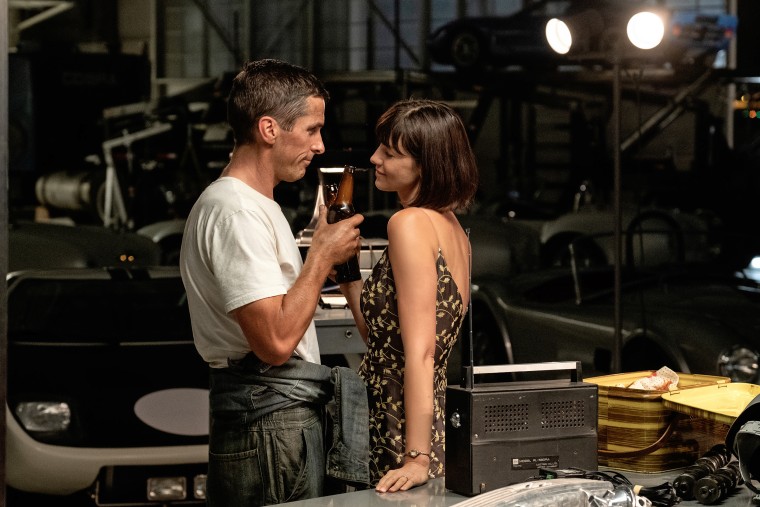“Ford v Ferrari” is a film about designing, constructing and racing cars that’s set in the mid-1960s. As such, the plot is fueled as much by testosterone as is it by gasoline.
It focuses on the partnership of the real Ken Miles (played by Christian Bale) and Carroll Shelby (played by Matt Damon), who accepted Henry Ford II’s challenge to produce a racing car that could out-perform his Italian rivals over at Ferrari. Clearly, “Ford v Ferrari” is about men, and that’s fine. But even films about men — of which there are many — can include fully-formed women. Unfortunately, the way “Ford v Ferrari” chooses to undermine its main female character is indicative of a frustrating trend in male adventure stories.
Clearly, “Ford v Ferrari” is about men, and that’s fine. But even films about men — of which there are many — can include fully-formed women.
Caitriona Balfe’s character Mollie Miles has the complicated honor of being the token woman in James Mangold’s film. Other than Ferrari’s English translator, who only repeats the words of men, and a few secretaries, who serve the purpose of proving that Ford’s operation is overstuffed and must be streamlined, Mollie stands essentially alone. When audiences first meet her, she’s dropping by her husband Ken’s garage and purring lines about engines and speed — this is how we know that she’s not a spoilsport. Mollie supports her husband’s passion. She even likes cars!
Mollie also loves Ken and their son, Peter (Noah Jupe). The marriage is depicted as a partnership, which is a positive. We see Ken go to the grocery store for the family and sensitively parent his child. Still, Mollie as an individual remains an enigma. Stoic and dry in some moments — like when she literally pulls up a chair to Ken's and Carroll’s immature scuffle in her front yard — Mollie acts dangerously impulsive in others. At one point, she puts her foot down and refuses to take on any more hours at work to support their struggling family. This stand might be more evocative if “Ford v Ferrari”ever told us what her job is.
For the last third of the movie, Balfe is required to squint nervously at a TV screen, watching Ken drive in the 24 Hours of Le Mans race that constitutes the story’s drawn out climax.
This is a trap that so many movies that revolve around thrill-seeking men with big dreams have fallen into. Someone has to represent what they are risking or leaving behind, and that usually falls to a wife or girlfriend character the narrative otherwise doesn’t have time for. Recent examples include Claire Foy’s Janet Armstrong in “First Man” (who reminded NASA that they were all, in fact, “a bunch of boys!”) and Liv Tyler’s Eve in “Ad Astra.” Linda Cardellini’s “Green Book” character Dolores also qualifies, as she’s basically there to keep the home fires burning and receive letters from her husband as he drives across the country. Dolores is the foil who reveals the movie’s male character’s depth, just as Mollie’s main role is to reinforce her husband’s bravery.
All of these actresses are capable and worthy of more than just hand-wringing and tearful phone calls. The softball lobbed at Balfe in “Ford v Ferrari”is especially insulting when you compare Mollie’s arc to that of Claire Randall, the time-traveling healer she’s played on “Outlander”for five seasons and counting. (Earning four Golden Globe nominations so far.) On “Outlander,” Claire has endured enormous personal loss and trauma, but she’s also carved out spaces for herself in venues where women aren’t expected or welcome and has even actively changed the course of history — not just for herself, but also for entire countries.
While Balfe does her best with the material she’s given, anyone who’s seen a single episode of her Starz series will walk away disappointed that she wasn’t trusted with more.
“Ford v Ferrari” is an acting showcase for Bale and Damon, who are admittedly magic together. But while Balfe does her best with the material she’s given, anyone who’s seen a single episode of her Starz series will walk away disappointed that she wasn’t trusted with more.
(Spoilers below.)
The salt in the wound comes at the conclusion of the film, however. Ken, as in real life, dies in an accident mere months after his record-breaking performance at Le Mans. Though her entire role in the drama has been to stand by her man, Mollie isn’t even given the space to mourn. Carroll goes to see her but decides to speak to her son about his father’s legacy instead. Mollie spends much of “Ford v Ferrari” humanizing Ken, and yet, there’s a limit to that interest as well. Peter is the one who is expected to carry Ken’s passion forward, even though Mollie shared it too.
Mollie’s character doesn’t make “Ford v Ferrari” a bad film — just an incomplete one. And if it’s successful, I have some suggestions for a more balanced yet still historically accurate follow-up. While no women competed in the ‘60s, 61 women have driven in 24 Hours of Le Mans. The first, Odette Siko, broke that glass ceiling in 1930 and is still the highest finishing female driver in the history of the endurance race. Sounds like a hell of a movie.

